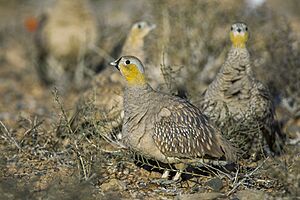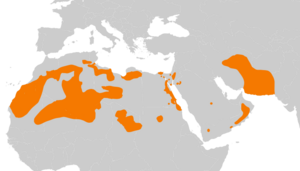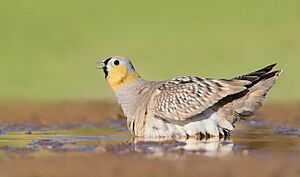Crowned sandgrouse facts for kids
Quick facts for kids Crowned sandgrouse |
|
|---|---|
 |
|
| Conservation status | |
| Scientific classification | |
| Genus: |
Pterocles
|
| Species: |
coronatus
|
 |
|
| World distribution | |
The crowned sandgrouse (Pterocles coronatus) is a cool bird that lives in the deserts of North Africa and the Middle East. It's part of the sandgrouse family, known for living in dry, open areas.
Contents
What Does It Look Like?
The crowned sandgrouse is a medium-sized bird. It looks pretty much the same color all over from far away. But up close, you can see its dark wing feathers. These dark feathers help tell it apart from other similar birds, like the spotted sandgrouse.
Its dark wing feathers stand out against the sandy color of its upper wings. The feathers under its wings are a creamy color. Adult male sandgrouse have a black "mask" on their face. They don't have any grey colors on their neck or chest.
Female and young sandgrouse don't have the black mask. They have dark, wavy lines (called vermiculations) across their chest and belly. This is different from the spotted sandgrouse, which has spots. These birds are about 27–29 cm (11 inches) long. Their wings can spread out to 52–63 cm (20–25 inches) wide.
Where Do They Live?
You can find the crowned sandgrouse across a wide area. They live in North Africa, starting from Mauritania in the west. Their home range stretches all the way through the Middle East to Pakistan in south Asia.
What Kind of Home Do They Like?
Crowned sandgrouse are desert birds. They especially like stony deserts, not so much the very sandy ones. In North Africa, they often nest among dark red sandstone rocks. Their feathers blend in perfectly with these rocks, helping them hide. They try to avoid places with too many plants or trees.
How Do They Live?
Crowned sandgrouse move around a lot, especially during the dry season. They might travel far from where they usually breed. For example, they are not common in northern Libya. But you can often find them there during the dry months from June to September.
They like to be in groups when it's not breeding season. This is especially true when they go to find water. They fly to water sources in the early and mid-morning. They also visit water again closer to sunset.
What Do They Eat?
These birds mainly eat hard seeds. They also munch on fresh shoots of grass and other small plants.
How Do They Raise Their Young?
The crowned sandgrouse makes a simple nest. It's just a shallow dip in the open ground. They don't add any soft lining to it. However, they might move small stones from the dip to its edge. This creates a circle of stones around the nest.
A female usually lays 2 or 3 eggs. The eggs are kept warm for a little over three weeks. After hatching, the chicks grow quickly. They are ready to fly (fledge) in about 24 to 28 days.
Sandgrouse Family Tree
Scientists study how different birds are related. The crowned sandgrouse is part of a group of birds that also includes the yellow-throated sandgrouse and the Madagascar sandgrouse. These birds are all in the Pterocles genus.
There are five different types, or subspecies, of the crowned sandgrouse:
- Pterocles coronatus coronatus: Found in the Sahara Desert, from southern Morocco to Sudan.
- Pterocles coronatus vastitas: Lives in the Sinai Peninsula and nearby parts of Israel and Jordan.
- Pterocles coronatus saturatus: Found in the hilly areas of inner Oman.
- Pterocles coronatus atratus: Lives in southern Arabia (except inner Oman), southern Iran, and parts of Afghanistan and Baluchistan.
- Pterocles coronatus ladas: Found in Sind, a region in Pakistan.



